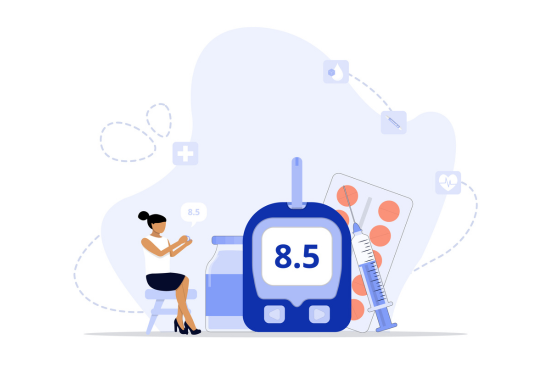Understanding Type 2 Diabetes: Causes, Symptoms, and Treatment Options

The Importance of Glucose Monitoring: Keeping Track of Your Blood Sugar Levels
03 Jul 2024
Blood sugar—that’s all you’ve been hearing ever since you discovered you have diabetes. But stop a moment, and think. If that’s all you mostly hear, it must be worth paying attention to, isn’t it? It’s the beginning of all that you’re going through, and it is also the solution to all you’re going through. And that’s exactly why we discuss the art of blood glucose monitoring, what it means to monitor it and how you can do it. All of it, pretty easily and without any stress.
What is blood glucose?
Every time you eat something, your body gets some energy out of it. But there’s a catch. The sugar from the food you eat has to reach your cells, for your body to be able to use it. Insulin is what helps in breaking down this sugar and taking it from your bloodstream to your cells. For non-diabetic people, it is a normal bodily process. But for people with diabetes, there’s often insufficient insulin in the body or there’s an inability in the body to be able to use the insulin (insulin resistance). Ultimately, the sugar doesn’t get converted to energy and the body ends up with elevated sugar levels.
Why is it important to monitor your sugar levels?
When you regularly track your blood sugar levels, you understand how much insulin your body needs and when. How much insulin you take and at what time are also major factors in your diabetes management. Frequent fluctuations in your sugar levels can also be quite risky for your body. In cases of very high (hyperglycemia) or low (hypoglycemia) blood sugar, it can get very serious if not treated on time.
Things like the food you consume, the physical activity you do, and the way you live also affect your glucose levels. For diabetic people, blood glucose monitoring gives an idea of how well their treatment plan works and if any changes are required. If you use insulin, the result can help in making decisions about food, physical activity, and dosing insulin.
However, it’s important to note that these things affect different people differently. Although understanding a certain pattern may help you manage your diabetes well, it’s not something that may work out the same way for another diabetic person. Diabetes affects everyone differently.
Sometimes, it can also work in unpredictable ways that even your healthcare professional may not fully understand. Hence, it’s best to always stay prepared and keep track of your levels. Know your body as well as you can, and manage diabetes well.

Can I monitor my blood sugar levels by myself?
Yes. Lucky for us, with today’s technology everything is possible. You can monitor your sugar levels at home using two techniques– 1. Glucose meter and finger stick and 2. Continuous glucose monitoring (CGM).
You can choose either or both methods depending on reasons like:
- Your diabetes type
- How often you’re recommended to check your sugar levels
- Access to technology
- Your health
Glucose Meter and Test Strips
Also known as “finger stick check”, using a glucose meter and test strips is a more common method of blood glucose monitoring.
How is it done?
- Use a small needle called a lancet to prick your fingertip and get a blood drop.
- Keep the blood drop against the test strip in the glucose meter
- In a few seconds, the meter will display your blood sugar level
Because this glucose testing method only measures your blood sugar one moment at a time, diabetics often need to check their levels using this technique. There are multiple variants available in glucose meters. Be sure to check with your healthcare provider about which one may suit you the best.

Continuous Glucose Monitoring (CGM)
The CGM method is where you wear a device that monitors your sugar levels all day. The sensor in the device helps in measuring your blood sugar levels. The device also helps form a graph later on that can show a summary of how your blood sugar levels keep changing and at what time.
However, CGM being a technology, there’s always a probability of inaccurate results. Hence, it’s not recommended to completely rely on CGMs and disregard finger-stick checks. It is crucial especially when your CGM readings don’t match your symptoms.
Be sure to check with your healthcare provider if you decide to opt for CGM as a blood glucose monitoring technique.
Keeping track of your blood sugar levels
In most cases, you will be able to save the results from your glucose meter. You can use an app on your smartphone, and track the levels. Alternatively, you can also keep a written version of your sugar levels with the exact date and time. These records can then be brought along during your appointment with your healthcare provider. If you’re using a CGM device, your records will automatically be saved and your healthcare provider should be able to access them anytime.
…
There you have it—a fuss-free guide to monitoring your blood sugar levels. It doesn’t matter if you’re a techie or not; measuring your glucose levels is pretty simple and easy to do, as we mentioned at the beginning of this article. Just pick a technique that suits you the best, and you’re good to go. Ensure you take help wherever needed and do not panic yourself. It’s just a matter of a few days until you’ve mastered the art of blood glucose monitoring. Just keep track, smile, and tell yourself, “I’ve got this!”Tracking your goals is easier with a healthcare assistant by your side. Download TatvaCare’s GoodFlip app and personalised diet and exercise coaching from experts. Set achievable goals, take diagonostic tests, monitor your progress, and control your diabetes for the long term. You can joing our popular Comprehensive Diabetes Remission programs to see actual results. Feel free to call us at +919974042363 or write to us at support@tatvacare.in to learn more about TatvaCare’s products and services.

Medically reviewed by
Dr. Devina Aswal 
MBBS, DDM, FCR, CIC
Recent Blog
- AI in Healthcare: Not a Threat, but a Smart Ally
- Your Clinic. Your Website. Your Brand.
- CDSS – Revolutionising Diagnosis with AI-Powered Clinical Decision Support System
- Handwritten to Digital in Seconds: SmartSync Converts Prescriptions Instantly
- Voice Rx by TatvaPractice: A Smarter Way to Digitise Prescriptions
Archives
Categories
- Asthma (20)
- Diabetes (15)
- Fatty Liver (20)
- High Blood Pressure (2)
- High cholesterol (2)
- Hypertension (2)
- Insulin Resistance (1)
- Obesity (8)
- PCOS (6)
- TatvaPractice (13)
Let’s Connect
Quick contact



